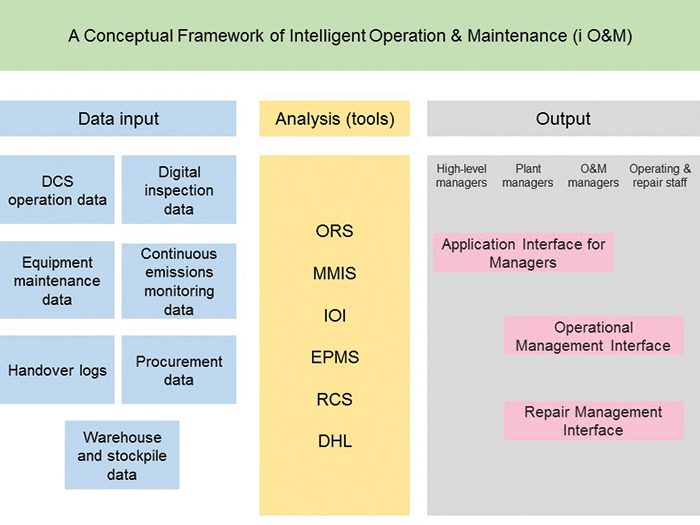Implementation of an intelligent operations and maintenance framework has improved operation rates, reduced unexpected shutdowns, and increased power generated per unit of waste at energy-from-waste power plants in Taiwan.
Many places in the world face the problems of growing waste and increasing demand for power as living standards improve. Energy-from-waste (EfW) plants offer two benefits through incineration: waste disposal and power generation.
Common factors that impact an EfW plant’s operational performance include a change in the nature of waste processed and aging equipment. To help plants stay in top shape, one option is to upgrade equipment and facilities. Another is to improve operational skills. A third option, which will be discussed here, involves intelligent management. This article will introduce a framework and its components for managing EfW plants intelligently and effectively by drawing on more than two decades of operational experiences from facilities across Taiwan.
Operation & Maintenance: Fundamental Aspects to Consider
As far as an EfW plant is concerned, intelligent management involves developing a set of tools to deal with operations and maintenance (O&M) more efficiently. This requires reviewing procedures and identifying key areas for improvement. From a management perspective, a few important areas that often need improvement include:
- Understanding how a plant is currently performing.
- Quick alert in face of abnormalities.
- Proper maintenance.
At ECOVE, we use a framework called “intelligent O&M” (i O&M) that incorporates the issues above and systematically manages the whole process (Figure 1). On the left of the framework is data input from daily operations, at the center are tools for analysis, and on the right are output interfaces designed for various users or scenarios.
 |
|
1. The intelligent operations and maintenance (i O&M) framework for managing energy-from-waste plants is shown here. Distributed control system (DCS) and other data from daily operations is input on the left. Analysis tools include the Operation Results Management System (ORS), Maintenance Management Information System (MMIS), Important Operations Information System (IOI), Electronic Patrol Management System (EPMS), Remote Consulting System (RCS), and Digital Handover Log (DHL). Each provide output to the right, which contributes to better O&M performance. Courtesy: ECOVE |
It is worth noting that this framework came to being gradually as intelligent management saw the need to incorporate more tools. The Operation Results Management System (ORS) and Maintenance Management Information System (MMIS) are the two fundamental and oldest tools before the conception of our i O&M framework. Other tools, such as Important Operations Information System (IOI), Electronic Patrol Management System (EPMS), Remote Consulting System (RCS), and Digital Handover Log (DHL), came later, each having an important contribution to better O&M performance. Below we will take a deeper look at each tool.
ORS. ORS is a real-time data collection and analysis tool to help EfW plant operators understand how a plant is currently performing. ORS can automatically compare input data to desired benchmarks, such as management threshold, design threshold, and historical data. Alerts are given in case of abnormality so that managers can quickly fix the problem.
ORS processes three types of data: waste processing, EfW O&M information, and system efficacy. Waste processing includes data such as municipal/industrial waste input, chemicals consumption, diesel consumption, water consumption, quantity of bottom ash, among many others. EfW information includes data such as quantity of waste processed and heating value. System efficacy, on the other hand, includes data such as boiler efficiency and power generation.
IOI. In order to provide managers with in-time data on O&M, ECOVE has developed the IOI system, which extracts key information from ORS and sends it to managers through mobile devices for them to remotely audit and supervise. It focuses on tracking targets, issuing alerts, and ensuring information mobility. Managers set management targets— for example, furnace temperatures, concentration of pollutant emissions, and waste treatment quantity—and IOI automatically compares operational figures of the day before to the targets. When abnormality is sensed, IOI automatically sends alerts to mobile devices so that managers can have in-time information on what happened and how to best deal with the situation.
In addition, IOI comes with a useful video monitoring feature. The traffic flow situation is an important detail that EfW plants need to monitor—some waste loaded on trucks needs to be inspected and controlled before entry. IOI allows managers and operators to monitor waste truck traffic through video images of weighbridges in real time, and lets them better control the entry of waste to EfW plants.
MMIS. The older an EfW plant becomes, the more likely it is to face issues such as key spare parts no longer being in production or aging equipment. To ensure EfW plants stay in top shape and equipment efficacy, maintenance is critical. There are three essential parts to facilities and equipment maintenance: routine, preventive, and corrective maintenance.
MMIS is an information system that systemizes and automates maintenance procedures, from planning and scheduling to implementation. It can generate a maintenance log for facilities and equipment, which helps an operator to analyze and assess which stage of the lifecycle it is at, so that old parts can be replaced in time. MMIS can also automatically generate a reminder spare parts inventories are low. The following is a brief description of how MMIS can be applied to routine, preventive, and corrective maintenance:
- Routine maintenance. As soon as an operator inputs past maintenance data and sets target periods, MMIS will automatically generate periodic maintenance work sheets and remind operators the number of days that have passed since previous maintenance, so that operators can make schedule arrangements and assign proper staff for the upcoming work. The system can also notify operators to prepare for spare parts and components so that inventory stays at a safe level. When a problem is sensed during routine maintenance, such as abnormal leakage, noise, vibration, or temperatures, the operator can instantly issue a repair worksheet with MMIS to increase overall equipment efficacy.
- Preventive maintenance. In contrast to routine care, preventive care is to foresee potential issues by analyzing data collected through various instruments (such as thermal imaging cameras, spectrum analyzer, and ozone testing) in order to prevent such issues from happening. To reach this goal, MMIS collects a series of data, such as equipment failure frequency, maintenance cycles, and past repair data, before analyzing it with statistical tools (such as multivariate regression). In that way, operators can better predict what will happen, why it will happen, and how to best arrange maintenance schedules to prevent occurrence.
- Corrective maintenance. Once a problem is sensed and needs to be repaired, operators can issue repair worksheets through MMIS and assign maintenance staff. The repair worksheets will indicate essential information such as equipment number, problem description, hazard analysis, isolation control, and latest maintenance record, so the staff can quickly deal with the problem and ensure staff safety.
EPMS. Routine patrols and inspection are the most effective ways of spotting potential plant irregularities and preventing problems from occurring. Traditionally, all data are recorded on paper. However, information searching such as indexing is very difficult. EPMS is a system specifically designed to ensure that inspections of equipment are done correctly, and that equipment operation parameters, as well as its status, can be instantly keyed in during routine patrols.
Massive inspection data are stored in a database. The system is then able to generate a graph indicating the individual trend of equipment operation. Coupled with MMIS’s maintenance log function, this allows operating staff to better assess equipment condition and arrange for maintenance or repair in advance, when necessary (Figure 2).
 |
|
2. The Electronic Patrol Management System offers convenient inspection and efficient data analysis. Courtesy: ECOVE |
RCS. A distributed control system (DCS) is a common computer control system for plant processes. In an EfW plant setting, the DCS’s primary function is for operators in the control room to monitor and control primary processes. These include checking operation criteria (such as parameter settings and sensor data) to see if they are correct.
RCS is used for remote inspection of DCS operation screens at each EfW plant. By connecting to the DCS operating screens at each EfW plant’s control room, the company management staff can remotely monitor the process settings of all plant DCS systems, parameter curves, and equipment operation status. This helps the management level to have timely understanding on how each plant is performing by analyzing the causes behind operational irregularity, and looking at the trends and changes.
DHL. A handover log is a tool that describes the details happening during each shift. Traditionally, logs are written on paper. This poses several drawbacks. For one, poor legibility and indexing difficulty hinder work efficiency during job handovers. For another, the process and equipment (such as the water system, boiler system, flue gas treatment system, and steam condenser system) across EfW plants are not necessarily identical, thus their work record and handover details may differ. For any operator that operates more than one EfW plant, having a consistent, yet flexible, management tool is critical.
DHL is designed to tackle these problems based on staff interviews. By digitalizing and systemizing the whole handover log, and connecting maintenance worksheets in MMIS, operators now have a digital handover tool that incorporates the common core features across all plants and yet can still cater to individual differences in terms of equipment and process. Operators can more effectively and timely view key announcements, equipment operation status, to-do lists, and work safety issues when handing over jobs to the next staff. They can also do keyword searches to backtrack target information speedily.
Intelligent Plant Management
These tools allow EfW plant operators to make O&M decisions faster, more efficient, and more accurate, which saves time and cost. Based on our experience, these tools have helped us achieve much better operation rates, far less unexpected shutdowns, and more power generated per unit of waste.
Government figures from 2020 show that among all 24 EfW plants across Taiwan, the operation rate of plants operated by ECOVE was 90.3%, compared to 87% from other operators; unexpected shutdowns that occurred in 2020 averaged 30 hours per furnace line, far less than the 259 hours per furnace line operated by other operators; and power generated was 605 kWh per a ton of waste in EfW plants operated by ECOVE, compared to 487 kWh per ton as operated by other operators.
Managing EfW plants with intelligent tools have proven to bring satisfactory outcomes that in the long run outweigh initial investments. To date, ECOVE has also applied intelligent management to other areas, such as managing water resources, electrical and mechanical facilities, waste solvents recycling, and solar power to enhance operational performance.
—Jui-Tung Hsu is a technical manager, and Ping-Yao Yeh, Yen-Chih Wang, and Yu-Chih Chen are engineers, all with ECOVE Environment Services Corp.










